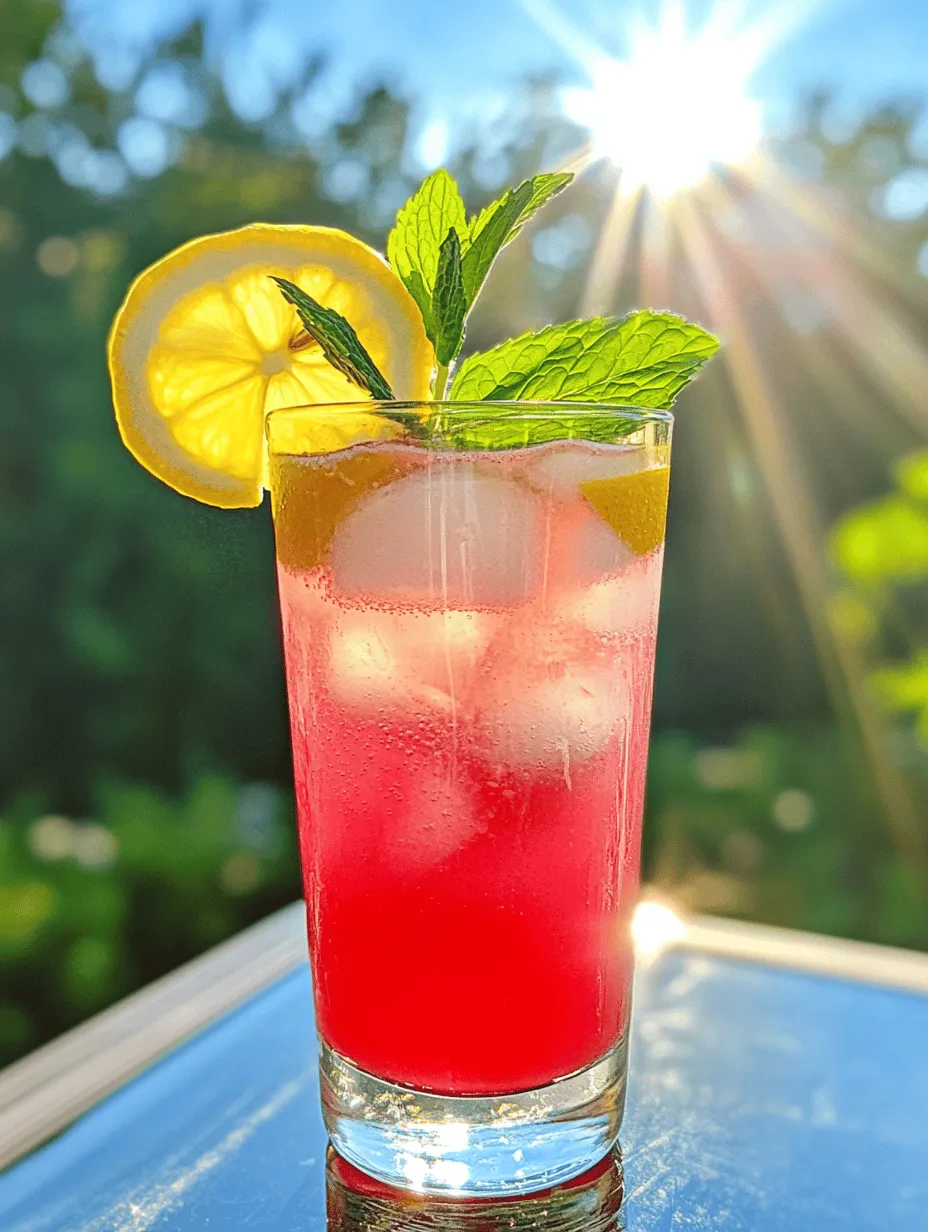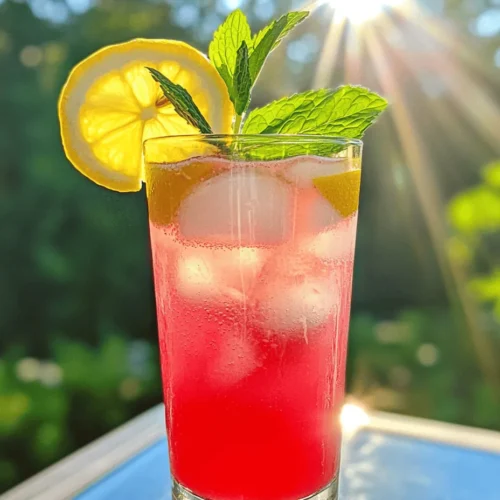Introduction
As the temperature rises and the sun shines brighter, there’s nothing quite like a refreshing drink to quench your thirst. With the arrival of warm weather, homemade beverages become a staple, providing a perfect way to stay cool and hydrated. While classic options like lemonade and iced tea reign supreme, it’s time to elevate your beverage game with a unique twist: Refreshing Rhubarb Lemonade.
Rhubarb, often overlooked and relegated to the realm of pies and desserts, is a fantastic ingredient bursting with tartness that pairs beautifully with the bright acidity of lemons. Its vibrant color and distinctive flavor make it an intriguing addition to any drink. This rhubarb lemonade is not only visually stunning but also offers a delightful balance of sweet and tart, making it a perfect choice for summer gatherings, picnics, or simply a relaxing afternoon at home.
Homemade lemonade is a timeless classic, but it becomes even more appealing when crafted from scratch with fresh ingredients. The allure of making your own lemonade lies in the ability to control the sweetness, adjust flavors, and create a beverage that perfectly matches your taste preferences. This rhubarb lemonade recipe is straightforward and allows you to impress your guests with a drink that’s both delicious and unique.
Understanding Rhubarb
History and Origins of Rhubarb
Rhubarb has a rich history that dates back thousands of years. Originally cultivated in China for its medicinal properties, it made its way to Europe during the 17th century, where it became popular not only for its culinary uses but also for its purported health benefits. The plant thrives in cooler climates and is characterized by its large green leaves and vibrant red or pink stalks. While the leaves are toxic and should never be consumed, the stalks are prized for their tart flavor, making them a favorite in desserts and beverages alike.
In North America, rhubarb is often associated with spring, as it is one of the first crops to emerge from the ground. Its short growing season means that it is best enjoyed fresh during its peak, making it an ideal ingredient for seasonal recipes. As a testament to its popularity, rhubarb is even celebrated with festivals in various regions, showcasing its versatility in both sweet and savory dishes.
Nutritional Benefits of Rhubarb
Beyond its culinary appeal, rhubarb boasts an impressive nutritional profile. It is low in calories and high in fiber, making it a great addition to a healthy diet. Rich in vitamins and minerals, rhubarb contains vitamin K, which is essential for bone health, as well as vitamin C, which supports the immune system. Additionally, rhubarb is packed with antioxidants that help combat oxidative stress in the body.
When combined with fresh lemon juice in this lemonade recipe, the health benefits are further amplified. Lemons are an excellent source of vitamin C and provide hydration, making this beverage not only a delicious treat but also a nutritious addition to your summer repertoire.
Flavor Profile: Tartness and How It Complements Lemon
The flavor profile of rhubarb is what sets it apart from other fruits and makes it a perfect companion for lemon. Its tartness is often compared to that of cranberries or sour cherries, providing a refreshing contrast to the sweetness typically found in beverages. When combined with the bright, zesty flavor of lemons, rhubarb creates a delightful balance that tantalizes the palate.
In this rhubarb lemonade, the natural tartness of rhubarb enhances the overall flavor, allowing for a uniquely tangy and refreshing drink. This combination not only excites the taste buds but also offers a refreshing escape from traditional lemonade recipes, making it a standout option for any occasion.
Why Choose Homemade Lemonade?
Comparison of Homemade Versus Store-Bought Lemonade
While store-bought lemonade may be convenient, there’s no comparison to the taste and quality of homemade versions. Commercially available lemonades often contain preservatives, artificial flavors, and excessive sugars that can compromise the natural taste of the drink. On the other hand, homemade lemonade, especially when made with fresh ingredients like rhubarb and lemons, is vibrant, flavorful, and free from unnecessary additives.
Making your own lemonade gives you complete control over the ingredients, ensuring that every sip is bursting with freshness. You can adjust the sweetness, acidity, and flavor intensity to suit your preferences, resulting in a drink that truly reflects your taste.
Health Benefits of Fresh Ingredients
One of the most significant advantages of homemade lemonade is the health benefits that come with using fresh ingredients. Freshly squeezed lemon juice provides a wealth of vitamins and nutrients, while rhubarb adds its own set of healthful properties. By using real fruits and vegetables, you can avoid the artificial ingredients commonly found in store-bought options.
Moreover, controlling the amount of sugar in your lemonade allows you to create a healthier beverage that won’t spike your blood sugar levels. For those looking to reduce sugar intake, there are numerous alternatives available that can be used in this recipe, ensuring everyone can enjoy a glass of refreshing rhubarb lemonade.
Customization Options for Taste Preferences
One of the joys of making homemade lemonade is the opportunity to customize it to your liking. This rhubarb lemonade recipe can be easily adapted to suit various taste preferences. Whether you prefer a sweeter drink, a more tart flavor, or even a hint of spice, the possibilities are endless.
You can experiment with different sweeteners, such as honey, agave syrup, or stevia, to find the perfect balance of sweetness. Additionally, you can infuse the lemonade with other flavors by adding herbs like mint or basil, or even spices like ginger or cinnamon. The beauty of homemade lemonade lies in its versatility, allowing you to create a refreshing beverage that’s uniquely yours.
Ingredients Breakdown
Creating the perfect Refreshing Rhubarb Lemonade begins with selecting the right ingredients. Here’s a detailed breakdown of what you’ll need:
Fresh Rhubarb: Selection and Preparation Tips
When choosing rhubarb for your lemonade, look for firm, crisp stalks that are vibrant in color. The color can range from deep red to light green, and while the red stalks are often considered more attractive, both varieties are delicious. Avoid stalks that appear wilted or have signs of browning, as these may be past their prime.
Before using rhubarb, be sure to wash it thoroughly to remove any dirt or debris. Trim the ends and cut the stalks into small pieces, which will help the rhubarb break down more easily during cooking.
Granulated Sugar: Alternatives for Sweetness
Traditional recipes often call for granulated sugar to sweeten the lemonade. However, you have the option to use various sweeteners based on your dietary preferences. Granulated sugar can easily be substituted with alternatives like honey, agave nectar, or coconut sugar. Each option will lend its own unique flavor to the lemonade, so feel free to experiment to find the one that suits you best.
For a sugar-free option, consider using natural sweeteners such as stevia or erythritol. Just be sure to adjust the quantities based on the sweetness level you desire, as these alternatives can vary in potency.
Freshly Squeezed Lemon Juice: Importance of Freshness
Freshly squeezed lemon juice is essential for achieving the best flavor in your rhubarb lemonade. Bottled lemon juice often lacks the vibrant acidity and natural oils found in fresh lemons. To get the most juice out of your lemons, roll them on the countertop before cutting to release the juices. Using a citrus juicer or a handheld reamer can help extract every drop of lemon goodness for your lemonade.
Optional Ingredients: Vanilla Extract, Lemon Slices, and Mint
To enhance the flavor of your rhubarb lemonade, consider adding a few optional ingredients. A splash of vanilla extract can add a subtle warmth and depth to the drink. Additionally, you may choose to garnish your lemonade with fresh lemon slices for a beautiful presentation or a sprig of mint for a refreshing touch. Both options not only make the drink visually appealing but also add to the overall flavor experience.
Step-by-Step Instructions for Making Refreshing Rhubarb Lemonade
Now that you have a clear understanding of the ingredients, let’s dive into the step-by-step instructions for making your own Refreshing Rhubarb Lemonade. This process begins with creating a luscious rhubarb syrup that serves as the foundation for your drink.
Making the Rhubarb Syrup
1. Prepare the Rhubarb: Begin by washing and chopping the rhubarb stalks into small pieces, about one-inch in length. This will help them break down more easily during the cooking process.
2. Combine Ingredients: In a medium saucepan, combine the chopped rhubarb, granulated sugar, and water. Use a ratio of about 1 cup of rhubarb to 1 cup of sugar and 4 cups of water. This will create a balanced syrup that’s sweet yet tart.
3. Gentle Boiling and Stirring: Place the saucepan over medium heat and stir the mixture until the sugar dissolves completely. As the mixture heats, it will begin to simmer. Keep an eye on it to ensure it doesn’t boil too vigorously, as this could lead to unwanted evaporation.
4. Visual Changes During Cooking: After a few minutes, you’ll notice the rhubarb starts to break down, releasing its vibrant pink color into the water. The syrup will take on a beautiful shade of pink, indicating that the rhubarb is infusing its flavor.
Simmering the Mixture
5. Simmer for Optimal Flavor: Once the sugar is dissolved and the rhubarb has started to break down, reduce the heat to low and let the mixture simmer gently. Allow it to cook for about 15-20 minutes, stirring occasionally to prevent sticking. This gentle simmering will help extract the full flavor of the rhubarb, creating a rich syrup.
6. Duration and Temperature for Optimal Rhubarb Breakdown: Monitor the mixture closely. The goal is to achieve a syrup that is thick enough to coat the back of a spoon but still fluid. If the syrup appears too thin, you can continue to simmer it for a few more minutes. Once you’re satisfied with the consistency, remove the saucepan from heat.
Through these initial steps, you’re well on your way to creating a delightful and refreshing rhubarb lemonade that will impress anyone who takes a sip. The combination of tart rhubarb and zesty lemon is a match made in heaven, promising a vibrant drink that embodies the essence of summer. Stay tuned for the next part of the recipe, where we will guide you through the final steps to complete your Refreshing Rhubarb Lemonade!




